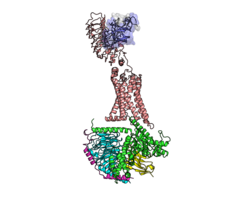黄体生成素/绒毛膜促性腺激素受体(英語:luteinizing hormone/choriogonadotropin receptor,缩写LHCGR也作 lutropin/choriogonadotropin receptor,LCGR或luteinizing hormone receptor,LHR )是一种主要出现在卵巢和睾丸的跨膜受体,但在一些性腺外的器官如子宫和乳房也有表达。该受体是G蛋白偶联受体(GPCR)的一种,既能与黄体生成素(LH)也能与绒毛膜促性腺激素(如人类的hCG)相互作用,其激活是在繁殖期间的荷尔蒙运作所需的。
事实速览 黄体生成素/绒毛膜促性腺激素受体, 已知的結構 ...
| 黄体生成素/绒毛膜促性腺激素受体 |
|---|
 |
|
| 識別號 |
|---|
| 别名 | LHCGR;, HHG, LCGR, LGR2, LH/CG-R, LH/CGR, LHR, LHRHR, LSH-R, ULG5, Luteinizing hormone/choriogonadotropin receptor |
|---|
| 外部ID | OMIM:152790 MGI:96783 HomoloGene:37276 GeneCards:LHCGR |
|---|
|
| 相關疾病 |
|---|
| leydig cell hypoplasia, type 1[1] |
|
| 為以下藥物的標靶 |
|---|
| lutropin alfa[2] |
|
|
| RNA表达模式 |
|---|
 |
| 查阅更多表达数据 |
|
| 直系同源 |
|---|
| 物種 | 人類 | 小鼠 |
|---|
| Entrez | | |
|---|
| Ensembl | | |
|---|
| UniProt | | |
|---|
| mRNA序列 | | |
|---|
| 蛋白序列 | | |
|---|
| 基因位置(UCSC) | Chr 2: 48.69 – 48.76 Mb | Chr 17: 89.02 – 89.1 Mb |
|---|
| PubMed查找 | [5] | [6] |
|---|
| 維基數據 |
|
关闭
LHCGR位于人类基因组上的2號染色體p21区,接近类似的促卵泡激素受体(FSHR)基因,长约70Kbp(FSHR为54Kpb)[7],除了与FSHR相似外,还类似于促甲状腺激素受体(TSHR)。
黄体生成素/绒毛膜促性腺激素受体与GIPC1能进行相互作用[8]。
Simoni M, Gromoll J, Nieschlag E. The follicle-stimulating hormone receptor: biochemistry, molecular biology, physiology, and pathophysiology. Endocr. Rev. 1997, 18 (6): 739–73. PMID 9408742. doi:10.1210/er.18.6.739. Hirakawa, Takashi; Galet Colette; Kishi Mikiko; Ascoli Mario. GIPC binds to the human lutropin receptor (hLHR) through an unusual PDZ domain binding motif, and it regulates the sorting of the internalized human choriogonadotropin and the density of cell surface hLHR. J. Biol. Chem. (United States). Dec 2003, 278 (49): 49348–57. ISSN 0021-9258. PMID 14507927. doi:10.1074/jbc.M306557200.
- Ji TH, Ryu KS, Gilchrist R, Ji I. Interaction, signal generation, signal divergence, and signal transduction of LH/CG and the receptor.. Recent Prog. Horm. Res. 1997, 52: 431–53; discussion 454. PMID 9238862.
- Dufau ML. The luteinizing hormone receptor.. Annu. Rev. Physiol. 1998, 60: 461–96. PMID 9558473. doi:10.1146/annurev.physiol.60.1.461.
- Ascoli M, Fanelli F, Segaloff DL. The lutropin/choriogonadotropin receptor, a 2002 perspective.. Endocr. Rev. 2002, 23 (2): 141–74. PMID 11943741. doi:10.1210/er.23.2.141.
- Amsterdam A; Hanoch T; Dantes A; et al. Mechanisms of gonadotropin desensitization. Mol. Cell. Endocrinol. 2003, 187 (1–2): 69–74. PMID 11988313. doi:10.1016/S0303-7207(01)00701-8.
- Fanelli F, Puett D. Structural aspects of luteinizing hormone receptor: information from molecular modeling and mutagenesis. Endocrine. 2003, 18 (3): 285–93. PMID 12450321. doi:10.1385/ENDO:18:3:285.
- Latronico AC, Segaloff DL. Insights Learned from L457(3.43)R, an Activating Mutant of the Human Lutropin Receptor. Mol. Cell. Endocrinol. 2007,. 260-262: 287–93. PMC 1785107
 . PMID 17055147. doi:10.1016/j.mce.2005.11.053.
. PMID 17055147. doi:10.1016/j.mce.2005.11.053.
- Nagayama Y; Russo D; Wadsworth HL; et al. Eleven amino acids (Lys-201 to Lys-211) and 9 amino acids (Gly-222 to Leu-230) in the human thyrotropin receptor are involved in ligand binding. J. Biol. Chem. 1991, 266 (23): 14926–30. PMID 1651314.
- Jia XC; Oikawa M; Bo M; et al. Expression of human luteinizing hormone (LH) receptor: interaction with LH and chorionic gonadotropin from human but not equine, rat, and ovine species. Mol. Endocrinol. 1991, 5 (6): 759–68. PMID 1922095. doi:10.1210/mend-5-6-759.
- Minegishi T; Nakamura K; Takakura Y; et al. Cloning and sequencing of human LH/hCG receptor cDNA. Biochem. Biophys. Res. Commun. 1990, 172 (3): 1049–54. PMID 2244890. doi:10.1016/0006-291X(90)91552-4.
- Rousseau-Merck MF; Misrahi M; Atger M; et al. Localization of the human luteinizing hormone/choriogonadotropin receptor gene (LHCGR) to chromosome 2p21. Cytogenet. Cell Genet. 1991, 54 (1–2): 77–9. PMID 2249480. doi:10.1159/000132962.
- Xie YB, Wang H, Segaloff DL. Extracellular domain of lutropin/choriogonadotropin receptor expressed in transfected cells binds choriogonadotropin with high affinity. J. Biol. Chem. 1991, 265 (35): 21411–4. PMID 2254302.
- Frazier AL; Robbins LS; Stork PJ; et al. Isolation of TSH and LH/CG receptor cDNAs from human thyroid: regulation by tissue specific splicing. Mol. Endocrinol. 1991, 4 (8): 1264–76. PMID 2293030. doi:10.1210/mend-4-8-1264.
- Keutmann HT; Charlesworth MC; Mason KA; et al. A receptor-binding region in human choriogonadotropin/lutropin beta subunit. Proc. Natl. Acad. Sci. U.S.A. 1987, 84 (7): 2038–42. PMC 304579
 . PMID 3470775. doi:10.1073/pnas.84.7.2038.
. PMID 3470775. doi:10.1073/pnas.84.7.2038.
- Jiang X, Dreano M, Buckler DR; et al. Structural predictions for the ligand-binding region of glycoprotein hormone receptors and the nature of hormone-receptor interactions. Structure. 1996, 3 (12): 1341–53. PMID 8747461. doi:10.1016/S0969-2126(01)00272-6.
- Atger M; Misrahi M; Sar S; et al. Structure of the human luteinizing hormone-choriogonadotropin receptor gene: unusual promoter and 5' non-coding regions. Mol. Cell. Endocrinol. 1995, 111 (2): 113–23. PMID 7556872. doi:10.1016/0303-7207(95)03557-N.
- Latronico AC; Anasti J; Arnhold IJ; et al. A novel mutation of the luteinizing hormone receptor gene causing male gonadotropin-independent precocious puberty. J. Clin. Endocrinol. Metab. 1995, 80 (8): 2490–4. PMID 7629248. doi:10.1210/jc.80.8.2490.
- Shenker A; Laue L; Kosugi S; et al. A constitutively activating mutation of the luteinizing hormone receptor in familial male precocious puberty. Nature. 1993, 365 (6447): 652–4. PMID 7692306. doi:10.1038/365652a0.
- Yano K; Saji M; Hidaka A; et al. A new constitutively activating point mutation in the luteinizing hormone/choriogonadotropin receptor gene in cases of male-limited precocious puberty. J. Clin. Endocrinol. Metab. 1995, 80 (4): 1162–8. PMID 7714085. doi:10.1210/jc.80.4.1162.
- Kremer H; Kraaij R; Toledo SP; et al. Male pseudohermaphroditism due to a homozygous missense mutation of the luteinizing hormone receptor gene. Nat. Genet. 1995, 9 (2): 160–4. PMID 7719343. doi:10.1038/ng0295-160.
- Kosugi S; Van Dop C; Geffner ME; et al. Characterization of heterogeneous mutations causing constitutive activation of the luteinizing hormone receptor in familial male precocious puberty. Hum. Mol. Genet. 1995, 4 (2): 183–8. PMID 7757065. doi:10.1093/hmg/4.2.183.
- Kremer H; Mariman E; Otten BJ; et al. Cosegregation of missense mutations of the luteinizing hormone receptor gene with familial male-limited precocious puberty. Hum. Mol. Genet. 1994, 2 (11): 1779–83. PMID 8281137. doi:10.1093/hmg/2.11.1779.